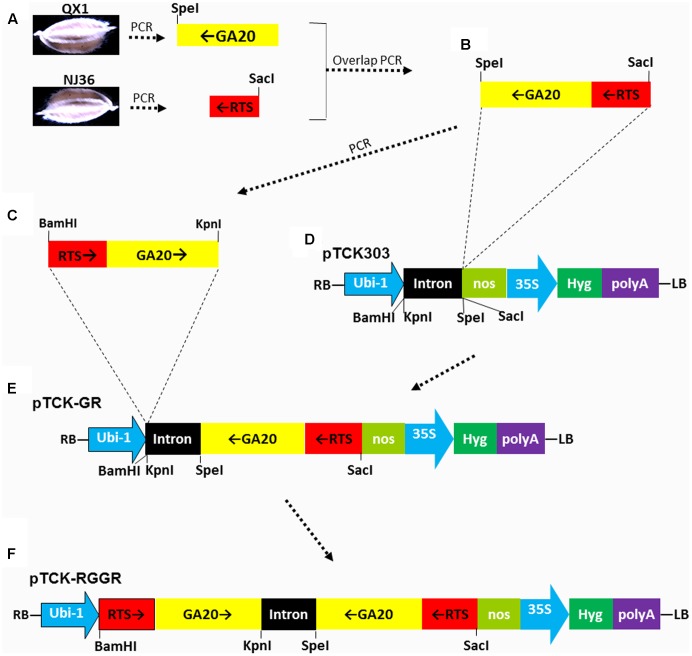FIGURE 1.
Schematic diagram of RNA interference (RNAi) vector pTCK-RGGR construction. Dash-dot arrows/lines indicate the relationship between the fragments or figure parts. Black arrows indicate the sense or antisense orientations of the DNA fragments RTS or GA20. (A) The GA20 fragment in antisense orientation of OsGA20ox2 was PCR-amplified from rice variety QX1 by using primer pairs GaF-Rts and GaR-Sp (Supplementary Table S3). A SpeI restriction site at one end of the fragment has been introduced via the primer GaR-Sp. The RTS fragment in antisense orientation of OsRTS was PCR-amplified from rice variety NJ36 by using primers RtsF-Sa and RtsR-Ga (Supplementary Table S3). A SacI restriction site at one end of the fragment has been introduced via the primer RtsF-Sa. (B) The GA20 and RTS fragments in antisense orientation were joined by overlap PCR with primers RtsF-Sa and GaR-Sp (Supplementary Table S3). (C) The joined RTS-GA20 fragment in sense orientation was PCR-amplified from the joined GA20-RTS fragment using primers RtsF-B/GaR-K, and the BamHI and KpnI restriction sites at the ends of the fragment have been introduced via the primers. (D) The backbone vector pTCK303, with BamHI, KpnI, SpeI, and SacI restriction sites for exogenous fragment insertion. RB, right border; LB, left border; Ubi-1, the maize (Zea mays) ubiquitin promoter; nos, nos terminator; 35S, CAMV 35S promoter; Hyg, hygromycin phosphotransferase gene. The intron was a 478-bp rice intron amplified from rice (Oryza sativa L. cv. Zhonghua 10) (Wang et al., 2004). (E) Intermediate vector pTCK-GR generated by cloning the joined GA20-RTS fragment in antisense orientation into the backbone vector pTCK303 at the SpeI and SacI restriction sites. (F) The joined RTS-GA20 fragment in sense orientation was cloned into the intermediate vector pTCK-GR through the BamHI and KpnI restriction sites, resulted in the hairpin RNAi vector pTCK-RGGR.

